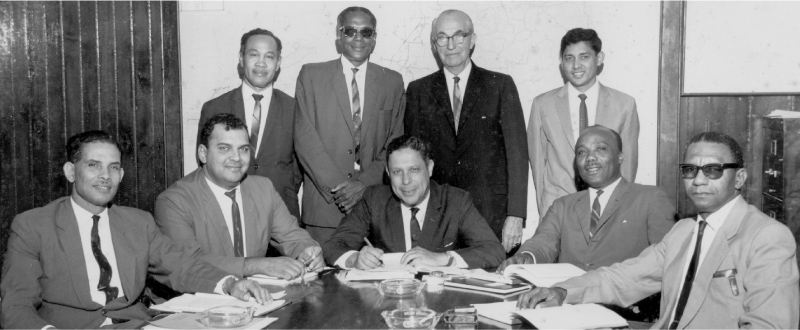
WASA First Board of Commissioners and Management, 1965
Seating: Knnolly Henderson, Errol Mahabir, Horrace Roberts (Chairman), Emmanuel Annisette, Cecil Dolly (Deputy Chairman) Standing: Aqui Phillips, Fitz Simon Belle, V. Mc Killop (Executive Director), Merlvyn Sankerali.
A look back as WASA enters Golden Jubilee
On September 1st 2014 WASA celebrated its 49th Anniversary and entered its 50th year as an organisation. As the Authority prepares to celebrate its Golden Jubilee in September 2015, it is important to examine how it and the water sector in Trinidad and Tobago has developed from 1965 to now.
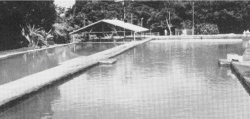
Maraval Waterworks constructed in 1853
Following the social turbulence caused by the Water Riots of 1903, the Colonial Government at the time made several attempts in the subsequent years to streamline and centralise the water and wastewater services in Trinidad and Tobago. This resulted in the first tariff structure being put in place in 1923, while the Central Water Board was established in 1935. In 1942, severe water shortages in several parts of the country led to the creation of a Water Enquiry Board, which recommended that administrative bodies in Arima, Port of Spain and San Fernando be united into one central authority.
Arising out of this past, the Water and Sewerage Authority (WASA) was established on September 1, 1965 by Act 16 of Parliament. The Water and Sewerage Act provided for the amalgamation of seven agencies then responsible for water and sewerage throughout the country – The Central Water Distribution Authority, the Port-of-Spain City Council, the San Fernando Borough Council, the Arima Borough Council, County Councils, The Water Divisions of the Ministry of Public Utilities, and the Sanitation Division of the Ministry of Public Utilities.
In 1965 total water production stood at 45 million gallons per day, and the only water treatment plants operating were the Maraval Waterworks – constructed 1853, Hollis Reservoir – constructed 1936, Hillsborough Reservoir – constructed 1952 and Navet Reservoir – constructed 1962. Ten years later the Navet Water Treatment Plant was upgraded and two new waterworks - Courland and Hillsborough West were constructed and commissioned in Tobago. This was followed by the construction of the North Oropouche Water Treatment Plant in 1979, and the construction of water treatment facilities at Acono, Lluengo/Naranjo, Caura, Aripo and Guanapo under the Northern Range Valley Project in 1980. Under the $105M Caroni Arena Project in 1981, the Arena Reservoir and the Caroni Water Treatment Plant were constructed.
For the decade spanning 1985 to 1995 a number of rural communities were provided with a pipe-borne water supply. Included were the commissioning of the Sans Souci Water Treatment Plant, the completion of the Pt. Fortin and St. Patrick's Water Supply Projects, the commissioning of the Hillsborough West Water Treatment Plant in Tobago, and the rehabilitation of Courland Waterworks.
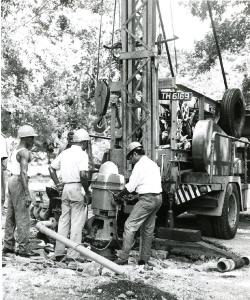
Well drilling exercise in the 1960’s
From the mid to the late 1990s $1.5 billion raised on the local market was used to fund a number of developmental works, among them the North, South and Tobago Water Projects, which included upgrade of the Caroni Water Treatment Plant, and the rehabilitation of water facilities in north and south Trinidad; while in Tobago the focus was on the development of new groundwater sources.
As the Authority entered the new millennium several major milestones were achieved, among them the commissioning of the La Fillette Water Supply Project and the Ravine Sable Water Treatment Plant, the completion of the upgrade to the Caroni Water Treatment Plant, and delivery of 22 million gallons of water per day through the new Desalination Plant at Point Lisas.
In spite of these developments over the years, the Authority failed to keep pace with the country's overall development and demand, as in 2010 only 18% of customers received a 24/7 water supply. Since then WASA has been engaged in a major infrastructural development programme aimed at achieving full 24/7 service delivery to customers by 2015. The Authority is well on its way to attaining this goal with 62% of customers currently in receipt of a 24/7 supply.
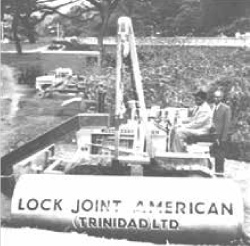
Start of the Lock Joint Island wide
sewerage Project 1962
As it relates to the Wastewater Sector, when the Authority was established, the low level sewerage system, built over the period 1902 - 1937, was inadequate to meet the wastewater treatment needs of a rapidly expanding country. One of the first responsibilities of the newly established WASA, was overseeing the major island-wide Sewerage Extension Project that was being executed by Lock Joint Ltd. The project which was completed in 1966 involved the construction of new wastewater treatment plants in Port-of-Spain, San Fernando and Arima, along with the installation of wastewater collection systems that included 384 km of street sewers and 5,000 manholes.
Since then, development of the wastewater sector has been sporadic, some of which include completion of the Caroni Wastewater Treatment Plant (WWTP) in 1980, construction of the Scarborough WWTP in 1994 and Beetham WWTP in 2004.
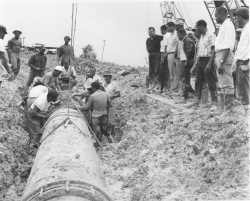
Mains Laying project 1960’s
Today WASA maintains 36 WWTPs, which services 30 percent of the population. In an attempt to improve wastewater collection and treatment, the Authority will soon oversee a Inter-American Development Bank (IDB) funded Multi-Phase Wastewater Rehabilitation Programme and Wastewater Infrastructure Rehabilitation Programme, which will see the construction of wastewater treatment plants and associated collection systems in the San Fernando, Malabar and Maloney catchments. This will represent the largest investment in the wastewater sector since the Lock Joint Project back in the 1960’s.